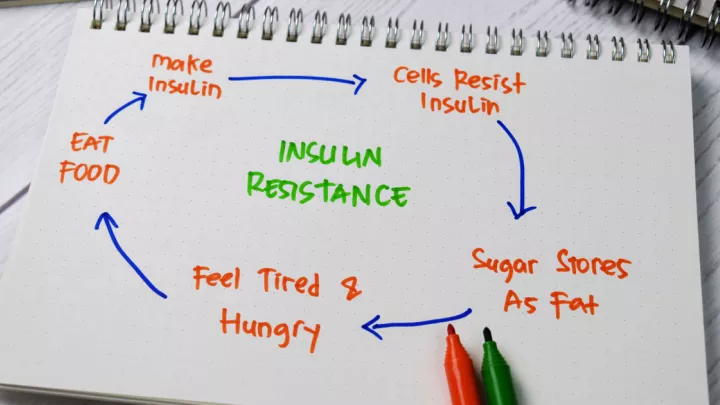5 best foods to improve insulin resistance

If you have insulin resistance, you may be able to reduce or even reverse it by adopting healthy lifestyle habits such as regular exercise and a healthy diet.
Insulin resistance occurs when cells in your body do not respond well to insulin. Insulin is produced by the pancreas and helps move glucose from the blood into cells, where it is used for energy. If you have insulin resistance, your pancreas must produce greater amounts of insulin to help maintain normal blood glucose levels.
Eating foods that raise your blood sugar triggers the pancreas to release insulin to absorb the sugars. Consuming large amounts of foods that raise blood sugar puts a lot of stress on the pancreas. Over time, this extra stress can worsen your insulin resistance and your condition may progress to Type 2 diabetes.
“Following a diet lower in refined or simple carbohydrates can help your body better manage sugar levels and may improve your insulin resistance,” says Shelby Hoskins, MS, RD, LMNT, CDCES, Nebraska Medicine diabetes educator and registered dietitian.
This can be achieved by eating a more balanced diet that includes a mix of choices from different food groups, such as fruits and vegetables, whole grains, beans and legumes and healthy dairy and fats. “This will help you digest your food slower, resulting in a slower, steadier rise in blood sugars and more sustained energy levels,” notes Hoskins.
Another trick to slow the rise in blood sugars is to pair a carbohydrate source with protein or a healthy fat. For example, pair an apple with peanut butter, whole grain crackers with cheese, or a banana with almonds.
While you do not need to eliminate any foods from your diet completely, the key is to be aware of how certain foods affect your blood sugar levels and how to balance or offset those with other food choices, says Hoskins.
Hoskins recommends the following foods to provide a more stable energy source and support insulin sensitivity.
1. Complex carbohydrates
These types of food are high in fiber and nutrients. To know if it is a whole grain, read the label, says Hoskins. The first ingredient should start with “whole,” as in whole wheat or whole oats.
Complex carbohydrates include:
- Whole wheat
- Oats
- Brown rice
- Quinoa
- Whole grain breads
- Whole grain pastas
- Whole barley
- Millet
- Bulgar wheat
- Buckwheat
- Whole rye
- Whole corn
2. Lean proteins
- Lean cuts of red meat
- Chicken
- Fish like salmon, tuna and trout
- Beans, lentils and legumes
- Nuts and seeds
- Nut butters
3. Fruits
All fruits are packed with fiber and nutrients, but some are higher in sugar than others, like grapes and bananas. So if you want to consume a larger portion, keep in mind that you can eat a cup of berries compared to half a banana for about the same sugar content, Hoskins says. With this in mind, some lower carbohydrate fruits include:
- Watermelon, cantaloupe and peaches
- Oranges, mangoes and pineapple
- Berries such as raspberries, strawberries and blueberries
4. Vegetables
While vegetables are always a good choice, keep in mind that some vegetables, like potatoes and sweet potatoes, are starchier than others and provide more carbohydrates. Vegetables with little to no carbohydrate include:
- Broccoli
- Dark leafy greens
- Tomatoes
- Peppers
- Cucumbers
- Carrots
5. Dairy and healthy fats
- Peanut butter
- High-protein, low-carb yogurt (Example: Greek yogurt)
- Cheeses
- Nuts
- Hard-boiled eggs
Foods to limit:
Foods high in added sugars can overload the body’s ability to produce enough insulin and should be limited.
These include:
- Sweetened beverages like soda, regular fruit juices, sweet tea or lemonade
- Foods high in saturated fats like whole milk, butter, coconut oil and red meat
- Sugary sweets such as candy, cookies, cake and ice cream
- White bread, rice, pasta and flour-based foods
- Packaged, highly processed foods and snacks
- Canned fruits, which are often packed in sugary syrup (find ones with no added sugar)
- Fried foods
- Alcohol
Tips for creating a balanced, insulin-resistant diet
Trying to make the changes in your diet needed to adhere to these food choices may seem overwhelming at first. To make it easier, Hoskins recommends the following tips:
- Set small, realistic goals. “Choose one or two things to change that are more easily achievable,” she says. “They don’t have to be huge changes. Maybe it’s adding two to three vegetables to your diet a day or reducing or eliminating juices or sugar-sweetened soda.”
- Put a timeframe on it. Then add to it as you achieve your goals
- Don’t beat yourself up if you have a bad day. Commit to starting fresh the next day and getting back on track
Need help controlling your blood sugars?
Call us at 800.922.0000 to schedule an appointment with one of our specialists.







